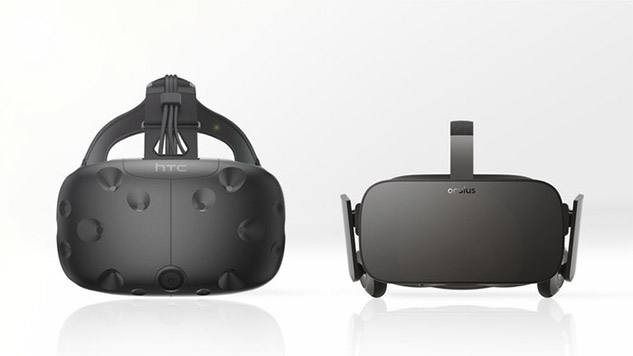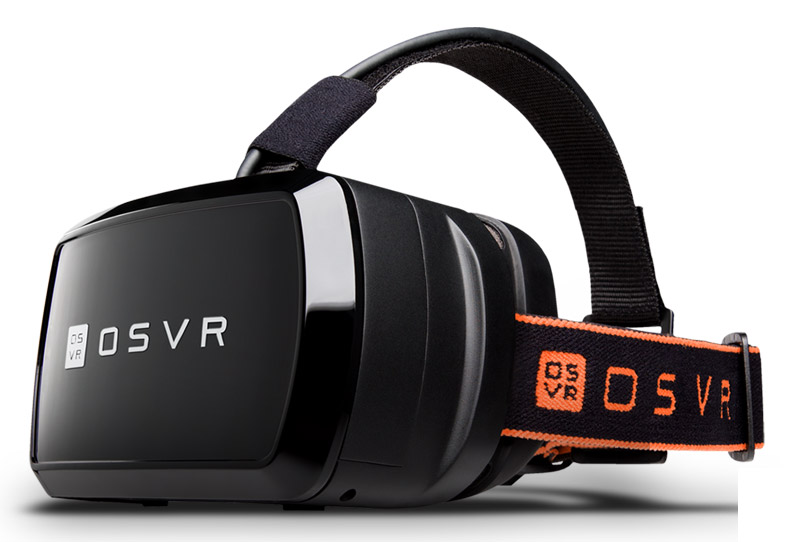When I reviewed the Oculus Rift and HTC Vive virtual reality headsets, I added a caveat to both pieces saying that I wouldn't make many direct comparisons with the other, since I wanted to review them on their own merits. As much as they are very similar, they also offer distinctly different experiences and I felt they deserved to be judged in their own right.
Of course though as fair as that was to both headsets, they do exist in the same marketplace. Both the Oculus Rift and HTC Vive offer a virtual reality experience and most people are unlikely to be able to afford one, let alone both. So the question of which to buy is an important one.
Now that I have both reviews published, I think it's time we looked at both headsets from the major manufacturers and weighed up their pros and cons against one another to decide which we would recommend you buy.
While it might already be obvious if you have read my previous review coverage on both headsets, there are still some direct comparisons that can be made which highlight the benefits and drawbacks of each design and which we would ultimately recommend you spend your money on.
Consider the Alternatives
Before we get to the face off between both the HTC Vive and Oculus Rift, it is worth considering whether one of the alternatives might be more suited to your needs and wants. They're all cheaper and they all offer a decent VR experience, but are they for you?
Google Cardboard
One of the biggest problems with virtual reality hardware right now is the cost involved. The headsets are expensive and the hardware required to run them is equally so. That means that unless you travel to a location where you can demo the VR gear yourself, getting an idea of what virtual reality is like can be rather difficult.
That's where Google Cardboard is a great solution. If you already have a compatible smartphone and a few pounds handy, you can grab a Google Cardboard (or equivalent) ‘headset' and you are off and running. It lacks positional tracking and the experiences available aren't of the calibre of the real-deal VR headsets, but to give you a rough idea of what VR is like, this is the cheapest way to go about it.
OSVR
Open Source Virtual Reality (OSVR) hardware is made by Razer and VR display firm Sensics, and perhaps by some other manufacturers soon enough. It's looking to keep virtual reality as hardware and platform agnostic as possible and wants to make headsets that are easy to take apart, easy to upgrade and most importantly can work with just about any other hardware and software out there.
Essentially, it wants to avoid tying users down to a single platform. That's a noble goal and one we can get behind considering all the Oculus VR exclusivity problems that have been faced in recent months.
The OSVR HDK2 is no slouch
The soon to be available HDK2 isn't quite as impressive as either the Rift nor the Vive, but it does have a decent display, good lenses and a wide-angle infrared camera for positional tracking. It's not quite available yet (though the earlier v1.4 model is) but will be soon and it will be just $400 (£283) when released. That's much cheaper than the mainstream competition.
PlayStationVR
Although not coming until October this year, PSVR may offer one of the easiest entry level points for consumers wanting to scratch a VR itch – especially if they already have a PS4. At that point the $400 (£283) price tag becomes very attractive.
Consider though that the screen is only 1080P and therefore has a more pronounced screen door effect. The question also remains how effective the Eye camera tracking and Move Motion controllers will be at adding some of the more advanced VR features to the mix.
It's also not out for a few more months, so this is no good if you are looking to get into VR now, but if you have a PlayStation 4 and don't have a high-powered PC too, this could well be your best option.
 KitGuru KitGuru.net – Tech News | Hardware News | Hardware Reviews | IOS | Mobile | Gaming | Graphics Cards
KitGuru KitGuru.net – Tech News | Hardware News | Hardware Reviews | IOS | Mobile | Gaming | Graphics Cards





No. I do not accept 110 degree field of view. You have to try harder Valve to impress me – I need EQUAL or better specs to StarVR on the Vive 2 or id better go and get a StarVR as soon as it’s out. StarVR + Star Citizen = gaming dream of Ultra Wide Quad HD (5120×1440) at 120Hz and 210 degree FOV.
Forget StarVR. I want HappyPonyVR, which is coming out with 280 degree field of view and 9260×3840 resolution at 120 Hz.
What’s that you say? HappyPonyVR doesn’t exist and can’t be bought yet and so is not even remotely a valid comparison against existing in-the-store VR headsets?
Yeah, same for StarVR.
Actually the correct answer is C- *if you are poor like me* wait until these only cost 199$ in 5 years or so, have tons of games, GOOD GAMES, and all the kinks worked out.
If you are rich then who cares. Buy Vive for now, then StarVR later. Can’t afford to do that? Then you probably shouldn’t be buying VR right now anyways. Pay your bills! RENT IS DUE and your landlord is pissed, and here you are playing with toys that cost a fortune! Have a nice day!
Almost nobody living in a modern economy can’t afford a Vive if they want one. It’s just a matter of choosing how you distribute your disposable income. You can use the same old cellphone for another 2 years instead of upgrading now, and you’ll have the money you need for a Vive. Or maybe use that 47 inch TV for a while longer, holding off on that 60 inch TV purchase. Or you could forego custom designer coffee for a couple months. Etc.
I’ve learned from reading many posts from Vive owners on Reddit over the last several months that it’s a big mistake to claim any head-mounted display fits “you” well or badly when you really mean that it fits “me” well or badly. Everyone’s head is different and so far, there’s no “one size fits all.”
To bad the Vive is so much more expensive though. And I really don’t care about the room tracking. I’ll stay in my chair tyvm.
are you a 20 something with no kids?
And what kind of video card are you going to be using without it running like total dogshit?
Room tracking is where its at. Im playing a few sitdown games like Project Cars and Total War, but they dont compare to the excitement of room scale games. they are incredible.
No, and I fail to see the relevance of your question.
I am aiming for a Vega 11, but who knows, i might go for a 1080Ti and wait for StarVR to launch, then get another for SLI when StarVR launches. It depends – If I find a video card that would do me a 120FPS minimum on a 2560x1440p monitor then im set to get another one and do 5120x1440p at 120FPS. Though unfortunately, no card can reach this high frame rate even at 1440p, which is a shame, Nvidia and AMD should make bigger chips and put more CUs in there, then STOP caring about TDP and go for 300-500W cards. Electricity is cheap enough nowadays…
$900 is a lot to spend on a luxury item when you have a family. Even if you can “afford it,” The money can go elsewhere to more important things — especially if you have kids. Your assumption is broad, and not accurate for a lot of people. It really sounds like the opinion of a 20 something who has yet to face a lot of life challenges. I say that not to offend you, but rather point out that you are generalizing and have formed some misconceptions about wealth and money management.
I’m fairly certain that every family I know spends thousands of dollars per year on entertainment and electronics already. Of course not every family would put the purchase of a Vive before other discretionary spending, because they value other things (big screen TVs, new cell phones, etc) more. But if they want to prioritize the Vive, I think most families could do so by cutting out other discretionary spending.
$800 is $67 per month over the course of a year. I would suspect that the vast majority of families could afford that by minorly rebudgeting some other discretionary spending.
My point is not to dispute the “if you’re poor like me” part of the original poster’s comment … if you are truly poor, and as a result have no cell phone, no TV, no car, no form of discretionary spending that you can rebudget for a Vive, then certainly you can’t get a Vive.
My point was simply to dispute the second half of the post, which was the “if you’re rich then who cares” part. You don’t HAVE to be rich to afford a Vive.
There is a wide range of income levels between “rich” and “poor” and most of those would find a Vive a perfectly acceptable level of expense if they are willing to buy it instead of spending discretionary money elsewhere.
That’s really the only point I’m trying to make.
My question with ALL VR headsets is, how do they handle peripheral vision?
I think that you, by thinking Bryan has failed to see the bigger picture and that families have more expenditures typically than singles, have actually failed to understand that your familial experience is a sample size of 1, and says nothing about other families.
The range of incomes for single people is just as broad as the range of incomes for families. There are families who couldn’t dream of buying a VR headset right now, just like there are single people who don’t make enough to even think about the purchase. Then there are both who could afford it with some rebudgeting. Finally, there are both single people and families for whom the purchase of a VR headset would be a drop in the bucket.
For instance, me. I have a couple of girls and a wife. We both make a decent salary. She lets me game a couple hours in the evening as long as I either cook dinner and clean up, or watch and play with the girls while she cooks dinner. I purchased a Vive a little bit ago. It was no big deal. It’s a hobby of mine, among others. She has hobbies, and she spends what she wants to on them as well. Yet I have friends with no kids, no mortgage, no car payment (driving older cars which are paid off), who couldn’t even afford to purchase a computer capable of running VR, let alone the VR headset. All of this is to say, your comment missed the point a lot more than the comment you were replying to.
That’s an assumption. I professionally analyze demographic data for the media industry. I’m not a parent. I’m basing my response on very real, measured science of what people spend money on.